Friday morning, March 28, 2014—the Hawaiʻi Space Exploration Analog and Simulation (HI-SEAS) crew is busy packing and preparing.
The three men and three women are hours away from the start of their mission—120 days of isolation in an extremely remote, thousand square foot habitat on Mauna Loa, Hawaiʻi; 8,200 feet above sea level. They can only leave the geodesic dome in simulation space suits.
The object of the University of Hawaiʻi at Mānoa project is to research how teams of astronauts will perform during long-duration space exploration to destinations like Mars.
It is estimated that a Mars mission would take three years to complete.
“Missions like this, reduce the risk of going to Mars,” said Kim Binsted, the principal investigator on the HI-SEAS project and a UH Mānoa associate professor from the Department of Information and Computer Sciences. “By practicing here on Earth, rehearsing the things we need to do on a trip to Mars, we are making it possible.”
The first HI-SEAS mission in 2013 was a food study.
NASA has committed $1.2 million to UH Mānoa for the next three HI-SEAS missions. The focus of mission number two is crew cohesion.
“There going to be taking a whole bunch of psych tests looking at their mood, looking at how they relate to each other, looking at the cognitive skills and how they change over time, but we are also going to be measuring their performance,” explained Binsted.

The habitat will simulate a base on Mars and each crewmember has a role to play.
“I will be responsible for the safety of the crew, meeting the tasks and objectives, both scientific and daily functions,” said HI-SEAS mission commander Casey Stedman.
“I will be focusing pretty heavily on psychological adjustment and team dynamics, group cohesiveness,” explained HI-SEAS crew member Ron Williams.
Fellow crew member Ross Lockwood will be working on maintaining equipment. “Knowing how things work here and there and being able to fix things quickly with improvised materials,” said Lockwood.
Except for the mission commander, each is also working on a scientific project or projects.
“We are going to be testing out some 3D printed surgical tools in isolated, confined and extreme environments,” said HI-SEAS crew member Tiffany Swarmer.
“I will have an experiment where I will have lights and plants and I will grow the plants. Once I have taken the data of the plants, we will be able to eat them,” explained crew member Lucie Poulet.
Crew member Annie Caraccio said her project is converting trash and waste from long duration space missions and turning it into useful commodities.
“Not only does it make for a realistic mission, so the crew will have real work to do,” said Binsted. “But we will be giving NASA really good bang for its buck.”
Before the long drive up Mauna Loa, the crew gathered for a final first aid training course. The six were selected from more than 120 qualified candidates from all over the world.
“We all had to meet certain physical and health requirements, we all had to meet certain education requirements, we all had to pass a certain bar of experience too and I think that is going to help a great deal,” said Stedman.
The crew finally arrived at the habitat just after sunset in a steady rain with the temperature hovering in the low 40s. They battled the elements as they moved their supplies and gear inside.
“Right now, I feel wet but I am trying to imagine it’s a Mars sandstorm,” said Caraccio. “It is a relief to finally get started. I’ve been mentally preparing for a while now, so I am ready to get in there and get the mission going.”
“I still can’t believe it,” said Poulet. “I’m still not realizing that we are going to be locked in for 120 days, but I’m very excited about it.”
A short time later the crew stepped into the habitat—their new home for the next four months—waved goodbye and closed the door.
The crewmembers will be providing updates via Facebook and Twitter.
The UH Mānoa run mission is scheduled to end in late July.
More UH News stories on HI-SEAS
- “Team performance factors the focus of new Mars simulation”
- “Crewmember participants sought for space studies”
- VIDEO: “Groundbreaking space exploration research at UH”
- “Long-duration space exploration study awarded NASA grant”
- “Contest seeks recipes for Mars mission”
- “Crew selected for Mars food mission”

